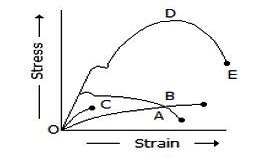Practice Test: Question Set - 09
1. Proof resilience per material is known as
- (A) Resilience
- (B) Proof resilience
- (C) Modulus of resilience
- (D) Toughness
2. The capacity of a strained body for doing work on the removal of the straining force, is called
- (A) Strain
energy
- (B) Resilience
- (C) Proof
resilience
- (D) Impact
energy
3. In a tensile test on mild steel specimen, the breaking stress as compared to ultimate tensile stress is
- (A) More
- (B) Less
- (C) Same
- (D) More/less depending
on composition
4. A column of length (l) with both ends fixed may be considered as equivalent to a column of length __________ with both ends hinged.
- (A) l/8
- (B) l/4
- (C) l/2
- (D) l
5. If the depth is kept constant for a beam of uniform strength, then its width will vary in proportional to
- (A) Bending moment (i.e. M)
- (B) Bending moment² (i.e. M²)
- (C) Bending moment³ (i.e. M³)
- (D) Bending moment⁴ (i.e. M⁴)
6. In a tensile test, near the elastic limit zone, the
- (A) Tensile strain increases more quickly
- (B) Tensile strain
decreases more quickly
- (C) Tensile strain
increases in proportion to the stress
- (D) Tensile strain
decreases in proportion to the stress
7. The pull required to crush the rivet per pitch length is
- (A) p.t.σt
- (B) d.t.σc
- (C) π/4
× d² × σt
- (D) π/4 ×
d² × σc
8. The total strain energy stored in a body is termed as
- (A) Resilience
- (B) Proof resilience
- (C) Modulus of resilience
- (D) Toughness
9. The extension of a circular bar tapering uniformly from diameter d₁ at one end to diameter d₂ at the other end and subjected to an axial pull of ‘P’ is given by
- (A) δl
= 4PE/ πl²
- (B) δl
= 4πld²/PE
- (C) δl
= 4Pl/πEd₁d₂
- (D) δl
= 4PlE/ πd₁d₂
10. The maximum bending moment for the beam shown in the below figure, is
- (A) wl²/3√3
- (B) wl²/6√3
- (C) wl²/9√3
- (D) wl²/12√3
11. Efficiency of a riveted joint is the ratio of its strength (max. load it can resist without failure) to the strength of the unpunched plate in
- (A) Tension
- (B) Compression
- (C) Bearing
- (D) Any one of the above
12. The pull required to tear off the plate per pitch length is (where p = Pitch of rivets, t = Thickness of plates, and σt, τ and σc = Permissible tensile, shearing and crushing stresses respectively)
- (A) (p
- 2d) t × σc
- (B) (p
- d) t ×
τ
- (C) (p
- d) t ×
σt
- (D) (2p - d) t ×
σt
13. In a belt drive, the pulley diameter is doubled, the belt tension and pulley width remaining same. The changes required in key will be
- (A) Increase key length
- (B) Increase key depth
- (C) Increase key width
- (D) Double all the
dimensions
14. In the below figure, curve D represents_________.
- (A) Mild steel
- (B) Cast iron
- (C) Concrete
- (D) Bone of
these
15. The bending moment of a cantilever beam of length ‘l’ and carrying a uniformly distributed load of ‘w’ per unit length is __________ at the fixed end.
- (A) wl/4
- (B) wl/2
- (C) wl
- (D) wl²/2
Next Tests:


